Are you curious about how sound travels, especially while exploring the vibrant landscapes and bustling cities of Vietnam? At SIXT.VN, we’re here to help you understand the science of sound and make your travels in Vietnam even more enriching and enjoyable. Discover how sound impacts your experiences in Vietnam with reliable travel services!
1. What Exactly is Sound?
Sound is a form of energy produced by vibrating objects. When an object vibrates, it causes the surrounding air molecules to vibrate as well, creating a chain reaction that propagates through a medium, such as air, water, or solids. This vibration is what we perceive as sound.
Think of a drum:
- When you hit a drum, the drumhead vibrates.
- This vibration causes the air around the drum to vibrate.
- These vibrations travel as sound waves to your ears.
- Your ears detect these vibrations and your brain interprets them as sound.
2. What are the Key Elements of Sound?
Sound is composed of several key elements that determine its characteristics:
- Frequency: The number of vibrations per second, measured in Hertz (Hz). High frequency sounds have a high pitch, while low frequency sounds have a low pitch.
- Amplitude: The intensity of the sound wave, which determines its loudness. High amplitude sounds are loud, while low amplitude sounds are soft.
- Wavelength: The distance between two consecutive peaks or troughs of a sound wave.
- Speed: The rate at which sound travels through a medium, which varies depending on the medium’s density and temperature.
3. Does Sound Need a Medium to Travel?
Yes, sound requires a medium to travel. Unlike light, which can travel through a vacuum, sound needs a substance like air, water, or solids to propagate. This is because sound travels as a wave of vibrations, and these vibrations need molecules to transmit the energy.
Robert Boyle’s experiment is a classic demonstration of this principle. By placing an alarm clock in a vacuum jar and removing the air, Boyle showed that the sound of the ringing clock diminishes as the air is evacuated, eventually becoming inaudible. This proves that sound cannot travel in a vacuum.
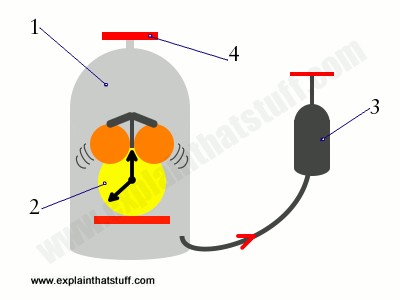 Robert Boyle Experiment
Robert Boyle Experiment
Robert Boyle’s famous experiment with an alarm clock.
4. How Does Sound Travel Through Different Mediums?
Sound travels through different mediums at different speeds, depending on the density and elasticity of the medium. Here’s a quick comparison:
- Air: Sound travels relatively slowly through air, at about 343 meters per second (767 mph) at room temperature.
- Water: Sound travels much faster through water, at about 1,481 meters per second (3,315 mph). This is why whales can communicate over vast distances in the ocean. According to research from Woods Hole Oceanographic Institution in 2018, marine mammals rely on sound for various purposes, including communication, navigation, and foraging.
- Solids: Sound travels fastest through solids, such as steel, at about 5,960 meters per second (13,342 mph). This is because the molecules in solids are more tightly packed, allowing vibrations to be transmitted more efficiently.
| Medium | Speed of Sound (m/s) |
|---|---|
| Air | 343 |
| Water | 1,481 |
| Steel | 5,960 |
5. What are Longitudinal and Transverse Waves?
Sound waves are longitudinal waves, meaning that the particles of the medium vibrate parallel to the direction of the wave’s propagation. In contrast, transverse waves, like light waves or water waves, vibrate perpendicular to the direction of propagation.
- Longitudinal Waves (Sound): The air molecules move back and forth in the same direction as the sound wave.
- Transverse Waves (Light/Water): The particles move up and down, perpendicular to the wave’s direction.
Understanding the difference between longitudinal and transverse waves helps explain why sound behaves differently than light and other types of waves.
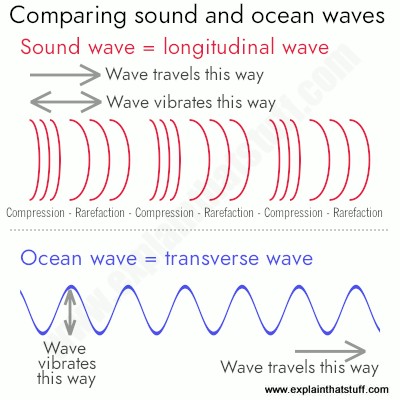 Longitudinal vs Transverse Waves
Longitudinal vs Transverse Waves
A comparison of longitudinal sound waves and transverse ocean waves.
6. What is Reflection and Diffraction of Sound Waves?
Sound waves, like other types of waves, can be reflected and diffracted.
- Reflection: Occurs when sound waves bounce off a surface. This is how echoes are formed. The time it takes for an echo to return can be used to estimate the distance to the reflecting surface.
- Diffraction: Refers to the bending of sound waves around obstacles or through openings. This is why you can hear sounds even when you are not in direct line of sight with the source.
These phenomena are particularly noticeable in certain architectural structures:
- Whispering Galleries: Domes or curved structures that concentrate sound waves, allowing whispers to be heard clearly at a distance.
- Amphitheaters: Outdoor venues designed to enhance sound projection, ensuring that performances can be heard by a large audience.
 US Capitol Whispering Gallery
US Capitol Whispering Gallery
US Capitol in Washington, DC, showcasing a whispering gallery inside its dome.
7. How Do Frequency and Amplitude Affect the Sound We Hear?
Frequency and amplitude are two key characteristics of sound waves that determine how we perceive sound:
- Frequency: Determines the pitch of a sound. High-frequency sounds are perceived as high-pitched (like a whistle), while low-frequency sounds are perceived as low-pitched (like a bass drum).
- Amplitude: Determines the loudness or intensity of a sound. High-amplitude sounds are loud, while low-amplitude sounds are soft.
Understanding frequency and amplitude helps us differentiate between various sounds and appreciate the nuances of music and speech.
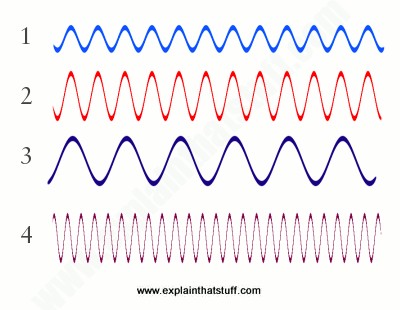 Amplitude and Frequency
Amplitude and Frequency
A simple explanation of the concepts of amplitude and frequency.
8. Why Do Different Instruments Sound Different Even When Playing the Same Note?
Even when different musical instruments play the same note (i.e., have the same fundamental frequency), they sound different because of their unique timbre or sound quality. Timbre is determined by the combination of the fundamental frequency and the harmonics (or overtones) that are produced by the instrument.
Each instrument produces a unique pattern of harmonics, which gives it its characteristic sound. For example, a violin and a piano playing the same note will have different patterns of harmonics, resulting in distinct sound qualities.
9. What is the Speed of Sound and How is it Measured?
The speed of sound is the rate at which sound waves travel through a medium. In air, the speed of sound is approximately 343 meters per second (767 mph) at room temperature.
The speed of sound can be measured using various methods, including:
- Echo Method: Measuring the time it takes for an echo to return from a known distance.
- Timing Method: Measuring the time it takes for a sound to travel between two points a known distance apart.
Here’s a step-by-step guide to measuring the speed of sound using the echo method:
- Stand approximately 100 meters away from a large wall.
- Measure this distance carefully and double it, recording the result.
- Clap your hands 20 times, listening for the echo. Clap again as soon as you hear it, repeating this process.
- Measure the total time from the first clap to the last echo.
- Calculate the total distance the sound traveled: 20 claps × 2 × distance to the wall (approximately 4000 meters or 4 km).
- Divide the total distance by the total time to find the speed of sound in meters per second (should be around 340 m/s).
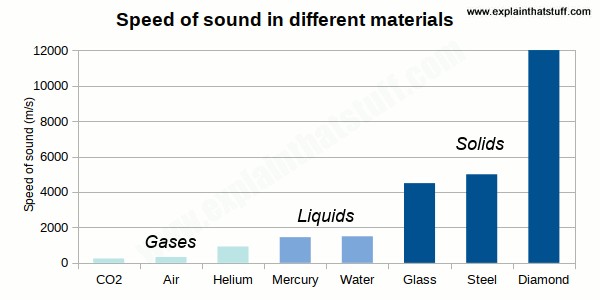 Measuring Speed of Sound
Measuring Speed of Sound
A chart illustrating the speed of sound in various materials.
10. How is Sound Used in Technology and Everyday Life?
Sound is used in a wide range of technologies and everyday applications, including:
- Communication: Telephones, radios, and other communication devices use sound to transmit information.
- Medical Imaging: Ultrasound is used to create images of internal organs and tissues.
- Navigation: Sonar (Sound Navigation and Ranging) is used to detect objects underwater.
- Music and Entertainment: Musical instruments, sound systems, and recording devices rely on sound to create and reproduce music.
11. Experiencing Sound in Vietnam: What to Expect
Vietnam is a country rich in culture and vibrant with sounds. Here’s what you can expect to experience in terms of sound:
- Urban Environments: Cities like Hanoi and Ho Chi Minh City are filled with the sounds of traffic, street vendors, construction, and bustling markets.
- Rural Areas: In the countryside, you’ll hear the sounds of nature, such as birds, insects, and farm animals, as well as traditional music and cultural performances.
- Cultural Events: Vietnam is home to numerous festivals and cultural events that feature traditional music, dance, and performances.
12. How Can SIXT.VN Enhance Your Travel Experience in Vietnam?
At SIXT.VN, we understand the importance of a smooth and enjoyable travel experience. We offer a range of services to help you make the most of your trip to Vietnam:
- Airport Transfers: Ensure a hassle-free arrival and departure with our reliable airport transfer services.
- Hotel Booking: Choose from a wide selection of hotels to suit your budget and preferences.
- Sightseeing Tours: Explore the best of Vietnam with our expertly guided sightseeing tours.
12.1 Airport Transfers
Navigating a new airport can be stressful. With SIXT.VN’s airport transfer service, you can relax knowing that a professional driver will be waiting to take you to your destination. This service is particularly useful in bustling cities like Hanoi and Ho Chi Minh City, where traffic can be overwhelming.
12.2 Hotel Booking
Finding the right accommodation is crucial for a comfortable trip. SIXT.VN offers a wide variety of hotels, from budget-friendly options to luxury resorts. We ensure that you find a place that suits your needs and preferences, whether you’re traveling solo, with family, or for business.
12.3 Sightseeing Tours
Vietnam is a country with a rich history and culture. Our sightseeing tours are designed to help you explore the best of what Vietnam has to offer. From the ancient temples of Hanoi to the stunning landscapes of Ha Long Bay, we provide expertly guided tours that will leave you with unforgettable memories. According to the Vietnam National Administration of Tourism, guided tours enhance the tourist experience by providing valuable insights into the local culture and history.
13. Top Destinations in Vietnam for Unique Sound Experiences
Vietnam offers numerous destinations where you can immerse yourself in unique sound experiences:
- Hanoi: Experience the bustling sounds of the Old Quarter, the serene ambiance of Hoan Kiem Lake, and traditional water puppet shows.
- Hoi An: Enjoy the tranquil sounds of the Thu Bon River, the vibrant atmosphere of the night market, and traditional music performances.
- Hue: Discover the solemn sounds of the Imperial City, the peaceful ambiance of the Perfume River, and traditional royal court music.
- Ho Chi Minh City: Immerse yourself in the bustling sounds of Ben Thanh Market, the lively atmosphere of Bui Vien Street, and modern music venues.
14. Understanding Cultural Sounds in Vietnam
Understanding the cultural sounds of Vietnam can greatly enhance your travel experience. Here are a few examples:
- Traditional Music: Vietnamese traditional music includes various genres such as ca trù, quan họ, and nhã nhạc, each with its unique style and instruments.
- Religious Chants: In temples and pagodas, you’ll often hear the chanting of Buddhist or Taoist scriptures, creating a serene and spiritual atmosphere.
- Street Performances: Street performers, such as musicians and storytellers, are common in many Vietnamese cities, adding to the vibrant atmosphere.
15. Practical Tips for Navigating Sound Environments in Vietnam
Navigating the diverse sound environments in Vietnam can be both exciting and challenging. Here are a few practical tips:
- Be Prepared for Noise: Cities like Hanoi and Ho Chi Minh City can be quite noisy, so bring earplugs if you are sensitive to sound.
- Respect Local Customs: Be mindful of noise levels in religious sites and residential areas.
- Explore Quiet Retreats: Seek out quieter areas, such as parks, gardens, and temples, to escape the hustle and bustle of the city.
16. Scientific Studies on the Impact of Sound on Travel Experiences
Research indicates that sound significantly impacts travel experiences. According to a study published in the Journal of Travel Research in 2020, ambient noise levels can affect tourists’ perceptions of a destination’s attractiveness and overall satisfaction. Understanding and managing sound environments can enhance visitor experiences and promote sustainable tourism.
17. Real-Life Examples and Anecdotes
- A Tourist’s Reflection: “I remember walking through the Old Quarter in Hanoi, and the sounds of motorbikes, vendors, and street performers created such a unique and vibrant atmosphere. It was chaotic, but also incredibly exciting.”
- Cultural Immersion: “Attending a traditional music performance in Hoi An was a highlight of my trip. The delicate sounds of the instruments and the beautiful melodies transported me to another world.”
18. Common Misconceptions About How Sound Travels
There are several common misconceptions about how sound travels:
- Sound Travels Faster Than Light: This is incorrect. Light travels much faster than sound.
- Sound Can Travel in a Vacuum: Sound requires a medium to travel and cannot propagate in a vacuum.
- Loud Sounds Travel Faster: The speed of sound is independent of its amplitude. Loudness does not affect the speed of sound.
19. Safety Measures Related to Sound in Travel
When traveling, it’s important to be aware of sound-related safety measures:
- Hearing Protection: Use earplugs or noise-canceling headphones in noisy environments to protect your hearing.
- Awareness: Be aware of your surroundings and listen for potential hazards, such as traffic or alarms.
- Communication: Ensure you can communicate effectively in noisy environments, especially during emergencies.
20. The Future of Sound and Travel
The future of sound and travel is likely to be shaped by advancements in technology and a growing awareness of the impact of sound on our experiences. Potential developments include:
- Noise-Canceling Technology: More advanced noise-canceling technologies to enhance comfort during travel.
- Immersive Sound Experiences: Integration of sound into virtual and augmented reality experiences to create more immersive travel simulations.
- Sustainable Soundscapes: Efforts to create more sustainable and harmonious sound environments in tourist destinations.
21. What Role Does SIXT.VN Play in Facilitating Memorable Travel Experiences in Vietnam?
SIXT.VN is dedicated to providing exceptional services that enhance your travel experience in Vietnam:
- Personalized Travel Plans: We tailor our services to meet your specific needs and preferences.
- Reliable Support: Our team is available to assist you with any questions or concerns you may have.
- Quality Assurance: We ensure that all our services meet the highest standards of quality and reliability.
22. How Can Travelers Get Started with SIXT.VN?
Getting started with SIXT.VN is easy:
- Visit our Website: Explore our range of services and destinations on SIXT.VN.
- Contact Us: Reach out to our customer service team for personalized assistance.
- Book Your Trip: Secure your airport transfer, hotel booking, or sightseeing tour with just a few clicks.
23. Conclusion: Maximizing Your Travel Experience with Sound Awareness and SIXT.VN
Understanding how sound travels and impacts our experiences can greatly enhance our travels in Vietnam. By being aware of the sound environments around us and utilizing the services of SIXT.VN, we can create more enjoyable and memorable travel experiences. SIXT.VN is committed to providing you with seamless and reliable services, ensuring that your trip to Vietnam is unforgettable.
Ready to explore Vietnam with confidence and ease? Let SIXT.VN take care of your travel needs. Contact us today to book your airport transfer, hotel, and sightseeing tour.
24. Call to Action
Ready to enhance your travel experience in Vietnam? Contact SIXT.VN today!
- Address: 260 Cau Giay, Hanoi, Vietnam
- Hotline/WhatsApp: +84 986 244 358
- Website: SIXT.VN
Book your airport transfer, hotel, and sightseeing tour now!
25. FAQ: Frequently Asked Questions About Sound and Travel in Vietnam
25.1 Why is sound important for travelers?
Sound is important because it significantly influences your perception and experience of a place. It can affect your mood, sense of safety, and overall satisfaction with your trip.
25.2 How does altitude affect the speed of sound?
As altitude increases, the air temperature generally decreases. Since sound travels slower in colder air, the speed of sound decreases with altitude.
25.3 Can I use sound to navigate in Vietnam?
While GPS is more reliable, you can use sound to orient yourself by listening for distinct landmarks, such as temples, markets, or natural features like rivers.
25.4 How can I reduce noise during my hotel stay?
Request a room away from elevators, ice machines, or busy streets. Using earplugs or white noise machines can also help minimize noise.
25.5 What are some traditional Vietnamese instruments I should listen for?
Some traditional instruments include the đàn bầu (monochord), đàn tranh (zither), and trống (drums). Try to attend a traditional music performance to hear them in action.
25.6 How does SIXT.VN ensure a quiet and comfortable airport transfer?
SIXT.VN uses well-maintained vehicles and professional drivers who are trained to provide a smooth and quiet ride.
25.7 Are there any apps that can help me measure sound levels in Vietnam?
Yes, there are several smartphone apps available that can measure sound levels, such as Sound Meter and Decibel X.
25.8 How can I experience the unique sounds of the Mekong Delta?
Take a boat tour along the Mekong River to hear the sounds of the water, local markets, and traditional music performances.
25.9 What is “white noise” and how can it help me sleep better while traveling?
White noise is a consistent, uniform sound that masks other distracting noises, helping you fall asleep and stay asleep. You can use a white noise machine or a smartphone app to generate white noise.
25.10 How can I find quieter destinations in Vietnam?
Consider visiting national parks, remote beaches, or smaller towns and villages away from the main tourist areas. These locations tend to offer a more peaceful and tranquil sound environment.
By understanding the science of sound and being mindful of the sound environments around us, we can enhance our travel experiences and create lasting memories. With SIXT.VN, you can ensure a smooth, comfortable, and unforgettable trip to Vietnam. Let us take care of the details, so you can focus on exploring and enjoying all that this beautiful country has to offer!
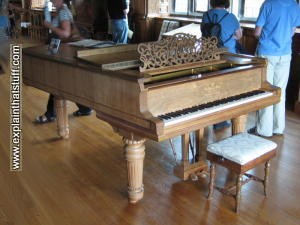 Steinway grand piano
Steinway grand piano
A Steinway grand piano: musical sound is a key element of human expression.



